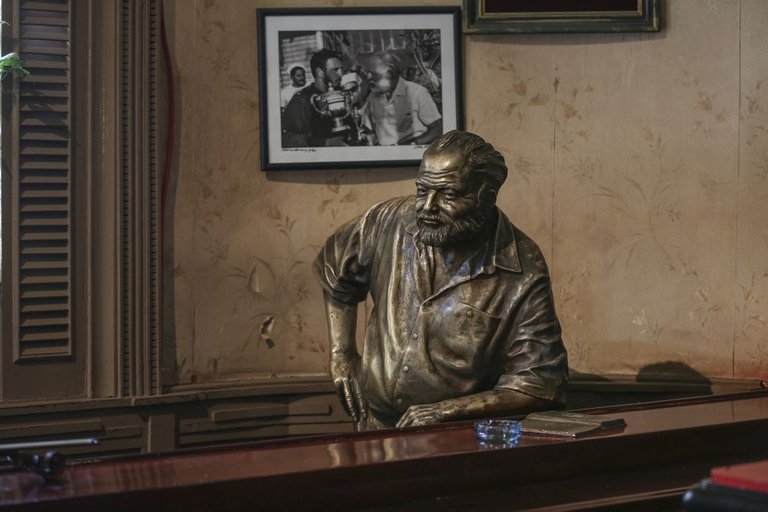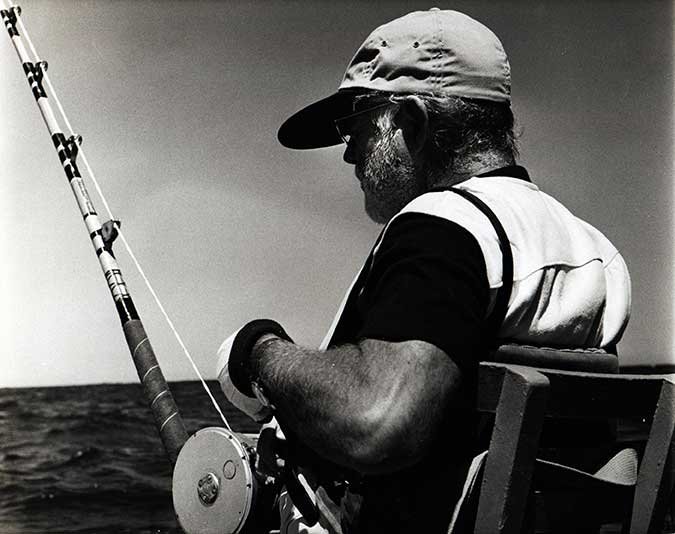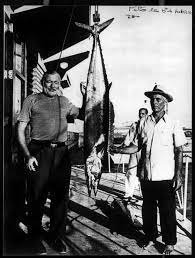
(Hemingway statue in Floridita bar photo: elviajero.elpais.com )
If you are passionate about literature you have surely read some classics. If you have read classics, you have surely looked at the odd Nobel Prize in Literature. By now you will have found authors such as García Márquez or Ernest Hemingway in your search. I want to stop at the latter, because although both have a close relationship with Cuba, the cult of the latter in some areas of Havana is quite large. I invite you to know the history of Ernest Hemingway in Havana, or better, Havana seen from his perspective.
Si te apasiona la literatura seguro que has leído alguno de sus clásicos. Si has leído clásicos seguro has ojeado algún que otro Nobel de Literatura. A estas alturas ya habrás encontrado en tu búsqueda autores como García Márquez o Ernest Hemingway. En este último me quiero detener, porque si bien los dos tienen una estrecha relación con Cuba, el culto a este último en algunas zonas de La Habana es bastante grande. Te invito a conocer la historia de Ernest Hemingway en La Habana, o mejor, La Habana vista desde su perspectiva.

(In his favorite activity: fishing photo: cubaconecta.com)
Who was Ernest Hemingway?
Ernest Hemingway was born in the United States in 1899. He was a prominent writer and journalist of the 20th century. In his literary work, important novels stand out, such as For Whom The Bells Turn, Drift Islands or the winner of the Nobel Prize for Literature The Old Man and the Sea.
Hemingway, along with other North American writers and intellectuals, formed the so-called Lost Generation, they were called that for participating in the First World War and then taking refuge in other countries.
His relationship with Cuba lies in the fact that he frequently traveled to it, and he lived here for a long time. At the end of his life he lived in Kay West, United States, where he committed suicide at the age of 62. His relatives commented that he suffered from mental disorders and delusions of persecution. Hemingway said that the US government was persecuting him, they even thought that this was a possible cause of his suicide.
As a very curious fact, years later FBI documents were leaked confirming the writer's suspicions: Indeed, the FBI was monitoring him.
**¿Quién era Ernest Hemingway? **
Ernest Hemingway nació en Estados Unidos en el año 1899. Fue destacado escritor y periodista del siglo XX. En su obra literaria destacan importantes novelas, como Por quién Doblan Las Campanas, Islas a la deriva o la ganadora del Premio Nobel de Literatura El viejo y el mar.
Hemingway, junto a otros escritores e intelectuales norteamericanos conformaron la llamada Generación Perdida, se les denominó así por participar en la Primera Guerra Mundial y luego refugiarse en otros países.
Su relación con Cuba radica en que viajaba frecuentemente a esta, y vivió aquí una larga temporada. Al final de su vida vivía en Kay West, Estados Unidos, donde se suicidó a los 62 años. Sus allegados comentaron que padecía de trastornos mentales y delirio de persecución. Hemingway decía que el gobierno estadounidense lo perseguía, pensaron incluso que esta era una posible causa de su suicidio.
Como dato muy curioso, años después se filtraron documentos del FBI donde se confirmaban las sospechas del escritor: Efectivamente, el FBI lo vigilaba.

(Image of the living room of his house in the vigia estate photo: onlinetours.es)
Hemingway in Cuba
Ernest Hemingway lived in Havana for more than 30 years. It was to be expected that, after the writer's fascination with Cuba, its people, its cultures and its places, the atmosphere of several of his most famous novels takes place in this country, such as Islas a la deriva and El viejo y el mar. Even in these novels he seems to get along with the Cuban Revolution.
On his first trips he stayed at the Hotel Ambos Mundos, always in room 511, which today is preserved as he left it, as a kind of museum.
Here in Cuba he met and lived with his third wife, Martha Gellhorn. Precisely next to her he would buy a one-story mansion in the middle of a farm on the outskirts of Havana, called Finca Vigía. Hemingway lived in this house during the winter, fleeing the extreme cold of the north of the United States, it was his home and his workplace for 20 years. The boat "Pilar" is also stored there, where the writer used to go fishing for long periods of time.
In the Havana Navy, Ernest Hemingway inaugurated a needle fishing tournament, the oldest of its kind in the world. Although for the first 4 years he himself won the first prize for catching the largest marlin.
At the Hatuey brewery, the writer, in a small act, would donate his medal of winner of the Nobel Prize for Literature to La Virgen de La Caridad del Cobre, whose sanctuary is located in Santiago de Cuba. He did it in honor of the patron virgin of the country and of the Cuban fishermen, according to him "The best people of Cuba", expressing his affection towards his friends.
When the so-called Cold War of the United States against Cuba began, the writer was forced to choose between the two nations. He chose Cuba.

(Hemingway at the marlin fishing competition photo: excelenciasgourmet.com)
Hemingway en Cuba
Ernest Hemingway vivió en La Habana por más de 30 años. Era de esperar que, tras la fascinación del escritor por Cuba, su gente, sus culturas y sus lugares, el ambiente de varias de sus más famosas novelas se desarrolla en este país, como en Islas a la deriva y El viejo y el mar. Incluso en estas novelas parece congeniar con la Revolución Cubana.
En sus primeros viajes se alojaba en el Hotel Ambos Mundos, siempre en la habitación 511, la cual hoy se conserva tal y como la dejó, como una especie de museo.
Aquí en Cuba conoció y vivió con la que fuera su tercera esposa Martha Gellhorn. Precisamente junto a ella compraría una mansión de un piso en medio de una finca a las afueras de La Habana, llamada Finca Vigía. Hemingway vivía en esta casa durante el invierno, huyendo del frío extremo del norte de los Estados Unidos, fue su hogar y su centro de trabajo durante 20 años. Allí se encuentra guardado también el bote “Pilar” donde el escritor solía salir a pescar largas temporadas.
En la Marina de La Habana, Ernest Hemingway inauguró un torneo de pesca de agujas, el más antiguo de su clase en el mundo. Aunque durante los 4 primeros años él mismo ganó el primer premio al pescar la aguja más grande.
En la cervecería Hatuey el escritor, en un pequeño acto, donaría su medalla de ganador de premio Nobel de Literatura a La Virgen de La Caridad del Cobre cuyo santuario está ubicado en Santiago de Cuba. Lo hizo en honor a la virgen patrona del país y de los pescadores cubanos, según él “La mejor gente de Cuba”, expresando su cariño hacia sus amigos.
Cuando comenzó la llamada Guerra Fría de los Estados Unidos hacia Cuba, el escritor se vio en la necesidad de elegir entre las dos naciones. Eligió a Cuba.

(International Nautical Club of Cuba "Hemingway" photo: prensa-latina.cu)
Hemingway's presence in Cuba today
In Havana the validity of the writer can be seen in several places. In bookstores proud to offer their most famous works. In museums such as his residence at La Finca Vigía, or his room at the Hotel Ambos Mundos.
Famous bars such as El Floridita or La Bodeguita del Medio were frequented by Hemingway and today they honor him with statues, photographs and even drinks in his name. In this last bar you can see on the wall a graffiti presumably written by him: “My mojito in La Bodeguita, My daiquiri in El Floridita”.
Where he used to fish, in the town of Cojímar (the inspirational town for the novel The Old Man and the Sea), he also has a statue, made with metal donations from the boats of the fishermen who knew him.
The Havana Marina currently bears his name "Ernest Hemingway" in honor of the fishing tournaments that he inaugurated and have lasted to this day. In 71 years of its first celebration, this annual tournament attracts amateur fishing tourists from around the world.
La presencia de Hemingway en la Cuba de hoy
En La Habana la vigencia del escritor se puede apreciar en varios sitios. En librerías orgullosas de ofertar sus más famosas obras. En museos como su residencia en La Finca Vigía, o su habitación en el Hotel Ambos Mundos.
Bares famosísimos como El Floridita o La Bodeguita del Medio eran frecuentados por Hemingway y a dia de hoy lo honran con estatuas, fotografías y hasta bebidas en su nombre. En este último bar se puede apreciar en la pared un grafiti presumiblemente escrito por él: “My mojito in La Bodeguita, My daiquiri in El Floridita”.
Donde solía pescar, en la localidad de Cojímar (pueblo de inspiración para la novela El viejo y el mar), también tiene una estatua, hecha con donaciones de metal de los botes de los pescadores que lo conocieron.
La Marina de La Habana actualmente lleva su nombre “Ernest Hemingway” en honor a los torneos de pesca que este inauguró y han perdurado hasta nuestros días. A los 71 años de celebrado por primera vez, este torneo anual atrae turistas aficionados de la pesca de todo el mundo.
Congratulations, your post has been added to Pinmapple! 🎉🥳🍍
Did you know you have your own profile map?
And every post has their own map too!
Want to have your post on the map too?
Me gustan muchos sus libros,porque como dije en el post están inspirados en mis pueblos cubanos.
El viejo y el mar me generó una verdadera desesperación, eso es un gran mérito para un escritor,lograr transmitir tanto. Gracias por sus palabras me alegro que le gustara❤️